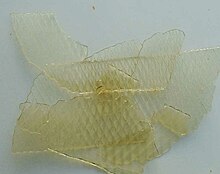Isinglass
The isinglass is the dried swim bladder of the Hausen (also known as beluga, a sturgeon species ), which is native to the rivers around the Caspian and Black Seas and which is mainly used to obtain caviar . Today the Hausen (like the other sturgeon species) is under species protection. There is a ban on imports into the USA and other countries. Isinglass is therefore hardly available any more. For example, swim bladders from other fish , some from South America , are also offered under this name. After the fish has been caught, the swim bladder is removed, placed in hot water, freed from veins and the muscles surrounding them , and then dried. Isinglass is made up of up to 70% collagen .
use
Isinglass only dissolves in acid (e.g. in tartaric acid ) and is mainly used for fining (clarifying) wine and beer . By adding something isinglass (about 1 gram per hectolitre) flakes sediment particles in the liquid from (collagen react with tannins to insoluble compounds that also the other suspended matter carried away) and breaks down more quickly on the ground from and can then be easily filtered out . The taste of the wine is not affected. The process is now partially replaced by refined filtration processes . The isinglass is still used today to make wine according to Jewish dietary laws , but only if the isinglass comes from a kosher fish.
Certain exemptions from mandatory food labeling expired on November 25, 2007. Since then, potential allergens have to be shown as mandatory information. According to statements by allergists , however, there is no clear risk assessment on this point. In contrast to albumin or lysozyme in winemaking, isinglass or fish gelatine as clarifying agents for wine or beer are exempted from the declaration requirement for an unlimited period.
Isinglass was already used in the 16th century as a gelling agent in leaf form (Hausen Blatern) for Charlotten or Sülzen , in the 18th century also for the production of medical plasters (hemostasis) and for treating fabrics and papers (finishing). Isinglass glue was also used as “gelatine” for certain high-quality printing processes such as collotype printing , as this hardens in conjunction with chromates when exposed to light.
Isinglass
Isinglass is also used to make isinglass glue , also known as isinglass (Colla piscium; see also Syndetikon ). The production of glue from the dried isinglass is complex. Added to this is the high price of the raw material, so isinglass glue is only used for special applications in restoration work and in instrument making (for example violin restorations). Its special properties are particularly strong adhesion with high elasticity in the hardened state and lower viscosity than comparable glues made from animal products such as hide glue or bone glue .
Individual evidence
- ^ Fining of wine with isinglass. Retrieved December 2, 2017 .
- ↑ How are kosher wines made? - Wein.de . In: Wein.de . April 15, 2016 ( wein.de [accessed December 2, 2017]).
- ↑ With the aim of consumer protection, an amendment to the EC food labeling directive (2000/13 / EC) was passed in November 2003.
- ↑ Results of the test with the enzyme allergy sorbent test (EAST) ( Memento from October 21, 2007 in the Internet Archive ) (PDF; 68 kB).
- ↑ Federal Law Gazette 2008 I p. 383 : Eighteenth ordinance amending the Wine Ordinance, relating to Annex 12 to Section 46b (as implementation of EU Directive 2006/142 / EC in national law).
- ↑ Balthasar Staindl: Ain artificial and useful cookbook . Otmar, 1547 ( google.de [accessed December 10, 2017]).
- ↑ Instructions for Finer Cooking. 2. much verm. And verb. Aufl. Haas, 1824 ( google.de [accessed December 10, 2017]).
- ↑ Handbuch der Drogisten-Praxis, Gustav Adolf Buchheister, Verlag von Julius Springer, Berlin, 3rd edition, 1893 online digitized version .
- ↑ Natural history and technology: for teachers in schools and for lovers of these sciences: Part of the general school encyclopedia . Schulbuchhandlung, 1794 ( google.de [accessed December 2, 2017]).
- ↑ Photographic archive: monthly. Reports on the progress of photography . Grieben, 1873 ( google.de [accessed December 2, 2017]).
- ^ Theodor Husemann: Handbook of the entire drug theory: With special consideration for the second edition of the German Pharmacopoeia for doctors and students . Springer-Verlag, 2013, ISBN 978-3-642-50689-5 ( google.de [accessed December 2, 2017]).
